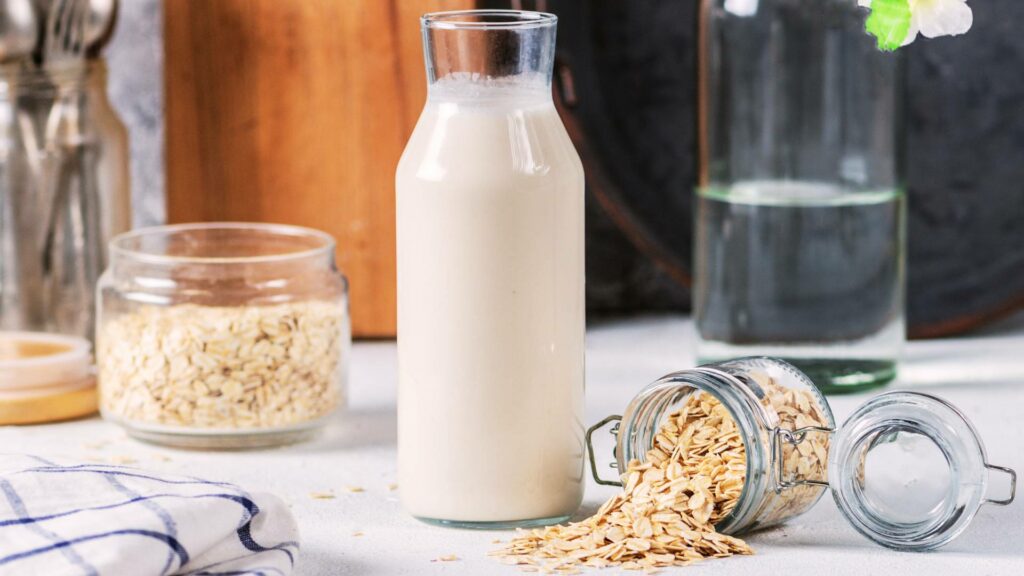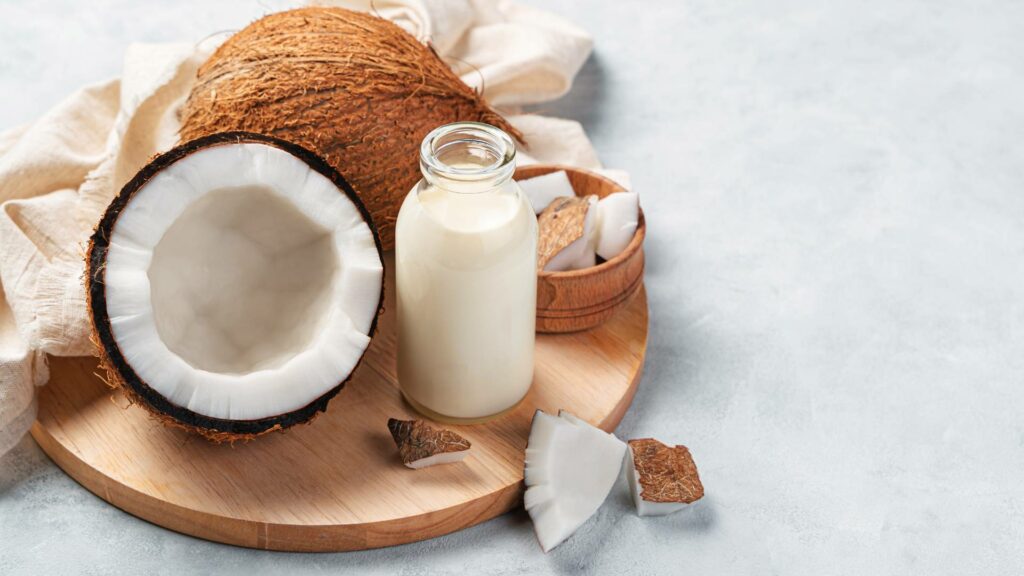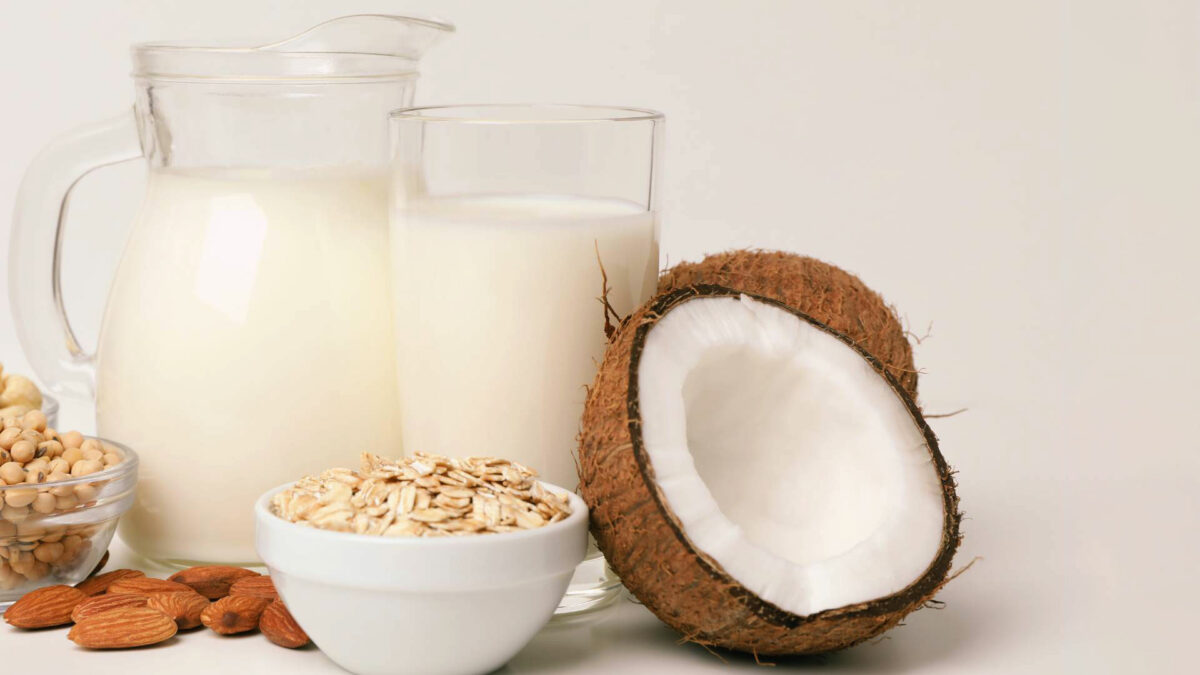The health of our family is the most important thing. It is best to nourish them with natural, delicious recipes and high-quality nutrients. And the best is made with our own hands for the whole family.
Don’t be afraid to experiment with making your own vegetable milk. It’s super easy and well worth it. Remember that any ingredient can be replaced by the one of your choice or one that you can get easily in your locality.
Homemade vegetable milk tastes delicious and is healthy because it is full of vitamins and minerals, so it is a great addition to our regular diet.
Let’s dive right into the recipes!
How To Make Oat, Coconut, and Almond Milk (with recommendations)
OAT MILK
1 liter recipe

Oat milk is super creamy with just the right amount of sweetness. It is perfect for those who may have a sensitivity to nuts and can’t drink almond milk. Store-bought can be a bit pricey, but homemade oat milk is very affordable, and best of all, it’s incredibly easy to make.
The rule for cereal milk
½ cup of cereal x 1 liter of water
INGREDIENTS:
- ½ cup white or whole grain oats
Tip: Using rolled oats would be ideal. Quick-cooking oats and steel-cut oats have different textures and thicknesses and may affect how creamy or slimy the milk turns out, so it’s best to opt for rolled oats.
The other thing to look out for is certified gluten-free oats. Packaged oats can be highly cross contaminated with wheat.
- 4 cups of purified water
Tip: To make sure your oat milk doesn’t turn out slimy, use ice cold water.
- Sweetener to taste (optional)
Tip: Prefer natural options such as vanilla extract, dates, honey, maple syrup, panela (raw sugar cane), agave syrup, monk fruit, or stevia, among others of your choice.
- A pinch of salt
Tip: You can also add 1 tsp of lemon juice, which will make it more available for the body to absorb.
INSTRUCTIONS:
- Soak the oatmeal for 8 to 12 hours in purified water.
Tip: You can let it soak overnight.
- Put the soaked oats in a strainer to get rid of the water.
- Blend the oats with half the water on high speed until smooth, then add the rest of the water and blend again.
Tip: To avoid making slimy oat milk, reduce the amount of time that you blend. In a high-powered blender, the friction of the blades can heat the ingredients, so only blend for 20 to 30 seconds, or until the mixture is smooth.
- If you have a high-powered blender, you don’t have to strain the mixture. If not, use a nut milk bag, cheese bag, blanket, or cheesecloth to strain the mixture. Squeeze.
- Add the sweetener of your choice or you can leave the milk unsweetened and then put it in the fridge.
- Oat milk stays fresh for up to a week in the fridge in jars with a lid, which is a bit longer than homemade nut milks.
- It works great in recipes for baked goods, smoothies, and other cold drinks. But it’s not the best choice for hot drinks because it can get thick and doesn’t foam as much as store-bought alternatives.
Oats are good for our health in many ways because they are a very complete cereal with carbs, protein, and fiber.
COCONUT MILK
1 liter recipe

INGREDIENTS:
- 1 cup tender coconut or dehydrated coconut (unsweetened)
- 4 cups of purified water (you can use part purified water and complement with coconut water)
- 1 pinch of salt
- Sweetener to taste (optional)
Tip: Prefer natural options such as vanilla extract, dates, honey, maple syrup, panela (raw sugar cane), agave syrup, monk fruit, or stevia, among others of your choice.
INSTRUCTIONS:
- Blend the coconut and water according to the capacity of your blender on high speed.
- If you have trouble getting tender coconut, use dehydrated coconut. You should soak it with 2 cups of purified water for 8 to 12 hours. You don’t have to strain it; you can just add 2 cups of clean water and blend it right away.
Tip: You can let it soak overnight.
- If the coconut is not tender or you used dehydrated coconut, it is necessary to strain the mixture using a nut milk bag, cheese bag, blanket, or cheesecloth. Squeeze.
- Add the sweetener of your choice or you can leave the milk unsweetened, and then put it in the fridge.
- Coconut milk lasts in the fridge for up to 5 days in jars with a lid.
Coconut contains nutrients that are essential to human health. It provides fat, protein, carbohydrates, and fiber. It is also a good source of vitamins and minerals such as vitamin C, folic acid, iron, magnesium, potassium, copper, manganese, and selenium.
ALMOND MILK
1 liter recipe

Almond milk is light, bright, clean, fresh, so much better than anything you’ll buy at the supermarket, and too easy to not try at home.
Almond milk rule
1 cup of almonds x 1 liter of water
INGREDIENTS:
- 1 cup of almonds
- 2 cups purified water (to grind) + 2 cups (topping)
- 1 pinch of salt
- Sweetener to taste (optional)
Tip: Prefer natural options such as vanilla extract, dates, honey, maple syrup, panela (raw sugar cane), agave syrup, monk fruit, or stevia, among others of your choice.
INSTRUCTIONS:
- Soak the almonds in purified water for 8 to 12 hours.
Tip: If you are in a hurry and you did not soak the almonds, you can soak them for 10 to 15 minutes in boiling water to activate them.
Another tip is to soak the almonds and freeze them in portions so the day you need them, you only have to take them out to grind.
- Pass the almonds through a strainer to drain the water.
- Blend the almonds and water according to the capacity of your blender on high speed.
Tip: To take advantage of the bagasse, do not add any sweetener when blending.
- Strain the mixture using a nut milk bag, cheese bag, blanket, or cheesecloth. Squeeze.
Tip: Use only 1 to 2 cups of water if you want less liquid milk. This way, you can use it for lattes or desserts.
- Add the sweetener of your choice or you can leave the milk unsweetened, then put it in the fridge.
- Almond milk lasts in the fridge for 3 to 5 days in jars with a lid.
- The almond pulp contains protein and fat, there’s a lot you can do with this!
DISCLAIMER
This information is not presented by a medical practitioner and is for educational and informational purposes only. The content is not intended to be a substitute for professional medical advice, diagnosis, or treatment. Always seek the advice of your physician or other qualified healthcare provider with any questions you may have regarding a medical condition. Never disregard professional medical advice or delay seeking it because of something you have read.



